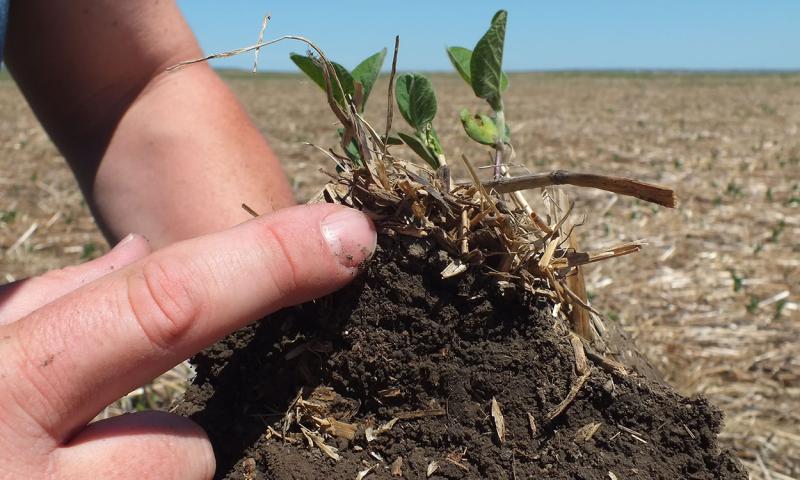Written collaboratively by Anthony Bly, David Karki and Jim Ristau.
Biological Agronomy is an adaptive soil management system used to build soil microbiology through intensive regenerative practices that increase carbon and nutrient availability for profitable crop production. Below are some of the benefits and risks associated with biological agronomy.
Biological Agronomy Benefits and Risks
Benefits
- Improves soil health through biological variety.
- Conserves and builds soil and water resources.
- Reduces use of imported fertilizer nutrient sources.
- Increases self-dependence on local biological sources.
- Self-sufficiency improves return on investment.
- Reduces greenhouse gas emissions from crop production systems.
- Restores the natural balance of fungi and bacteria to the soil.
Risks
- Potential for reduced productivity as soil biology gradually transitions from bacteria to fungi/bacteria based.
- Biological applications increase number of spray applications (in addition to weed).
- Increase in short-term expenses, however, offset by significant reduction in fertilizer expenses in a long run.
- Field appearances different from traditional high-input fertilizer cropping systems.
- Lack of readily available resources will increase the amount of time invested in sourcing up-to-date educational materials.
Overarching Review of Biological Agronomy System

The biological agronomy system approach focuses on building soil microbiology and, therefore, enhancing the carbon (C), nitrogen (N), phosphorus (P) and other soil nutrient cycles. Currently, for every 1% soil organic C, there is about 1,000 lbs./a of organic N. However, only a small part of this N pool is available for each crop year’s nitrogen needs. With recent focus on soil health and sustainable agriculture practices, we have gradually learned that healthy soils contain a good balance of microbial organisms that have beneficial relationships with plants and help uptake un-tapped nutrients that are vital to plant health and performance. Biological agronomy challenges this view, as it focuses on building and using the organic soil nutrient availability through applications of microbial rich extracts from locally derived composts. Microbial-rich compounds are developed locally and applied as seed and in-furrow treatments at planting, and during the fall as soil drenches and foliar applications to growing crops.
Biological agronomy and associated management practices have been adopted by many successful farms in most all crop growing regions, not only in the United States, but globally. Farmers using the biological approach usually adopt no-tillage and crop rotations that will allow incorporating cover crops to feed soil microbial communities while maintaining the biological variety. Both, conventional and USDA-certified organic producers are adopting the biological agronomy approach.
The goal of biological agronomy is to create a healthy soil ecosystem that not only maintains higher yields with lower inputs but also provides environmental benefits. Food products for human consumption produced from biologically commodities can have significant human health benefits.
Scientific References
- Calvo P., L. Nelson and J.W. Kloepper. 2014. Agricultural Uses of Plant Biostimulants. Plant Soil (2014) 383:3-41; DOI 10.1007/s11104-014-2131-8.
- Gerry Gillespie and David Harwick. 2018. Bioferments, Biostimulants and Biofertilizers. Bioferments Fact Sheet v2 2018. Soil Land Food and ROTS.
- Mitchell J.P., D.C. Reicosky, E.A. Kueneman, J. Fisher and D. Beck. 2019. Conservation Agricultural Systems. CAB International 2019 (Online ISSN 1749-8848); doi 10.1079/PAVSNNR201914001.
- Paungfoo-Lonhienne et al. 2010. Turning the Table: Plants Consume Microbes as a Source of Nutrients.
- Popko M. I. MIchalak, R. Wilk, M. Gramza, K. Chojnacka and H. Gorecki. 2018. Effect of the New Plant Growth Biostimulants Based on Amino Acids on Yield and Grain Quality of Winter Wheat. Molecules 2018. 23, 470; doi:10.3390/molecules23020470.
- White J.F., K.L. Kingsley, S.K. Verma and K.P. Kowalshi, 2018. Rhizophagy Cycle: An Oxidative Process in Plants for Nutrient Extraction from Symbiotic Microbes. Microorganisms 2018, 6, 95; doi:.10.3390/microorganisms6030095.


